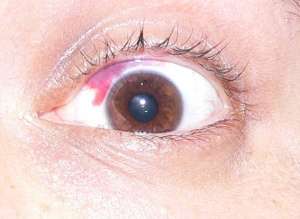Subconjunctival hemorrhage
Background
- Bleeding of the conjunctival vessels into the subconjunctival space
- Can be spontaneous or related to trauma
- Spontaneous can be secondary to anticoagulation, bleeding diathesis, etc.
- If large and associated with trauma, need to maintain suspicion for occult globe rupture (obscured by hemorrhage)[1]
- Bilateral and recurrent subconjunctival hemorrhage should have bleeding diathesis workup
Clinical Features

Subconjunctival hemorrhage
- Painless
- No effect on vision
- May recall a history of mild trauma or valsalva
- Examination
- Fresh red blood on a white sclera with clear borders[1]
- Masks the conjunctival vessels
Differential Diagnosis
Unilateral red eye
- Acute angle-closure glaucoma^
- Anterior uveitis
- Conjunctivitis
- Corneal erosion
- Corneal ulcer^
- Endophthalmitis^
- Episcleritis
- Herpes zoster ophthalmicus
- Inflamed pinguecula
- Inflamed pterygium
- Keratoconjunctivitis
- Keratoconus
- Nontraumatic iritis
- Scleritis^
- Subconjunctival hemorrhage
- Orbital trauma
^Emergent diagnoses
^^Critical diagnoses
Evaluation
- Clinical diagnosis
- Consider fluorescein staining to evaluate for corneal injury if suggested by history or if patient complains of pain[1]
Management
- Reassurance (will generally resolve within 10-14d)[1]
See Also
References
- Mahmood, Ahmed R., and Aneesh T. Narang. "Diagnosis and management of the acute red eye." Emergency medicine clinics of North America 26.1 (2008): 35-55.
This article is issued from
Wikem.
The text is licensed under Creative
Commons - Attribution - Sharealike.
Additional terms may apply for the media files.